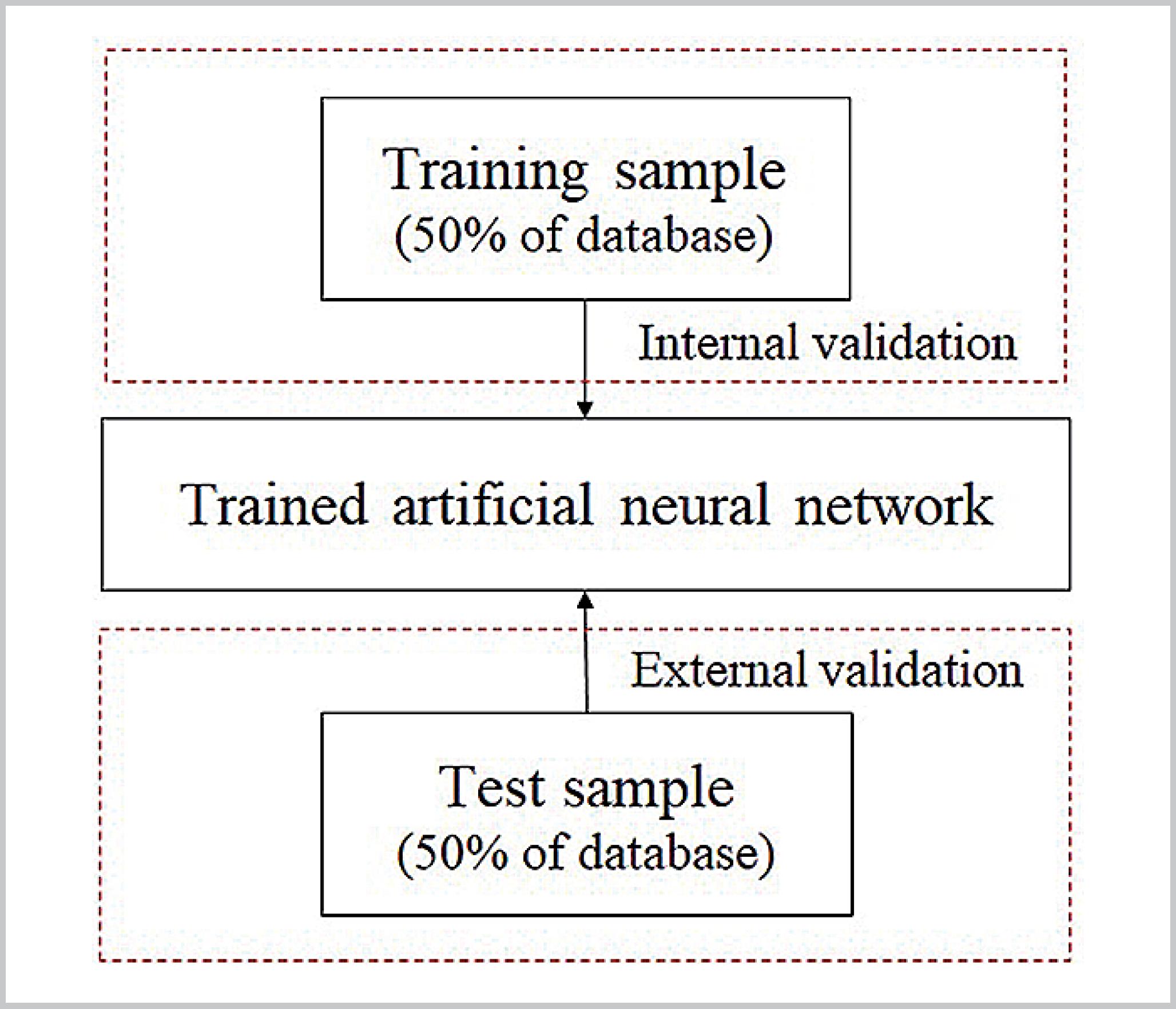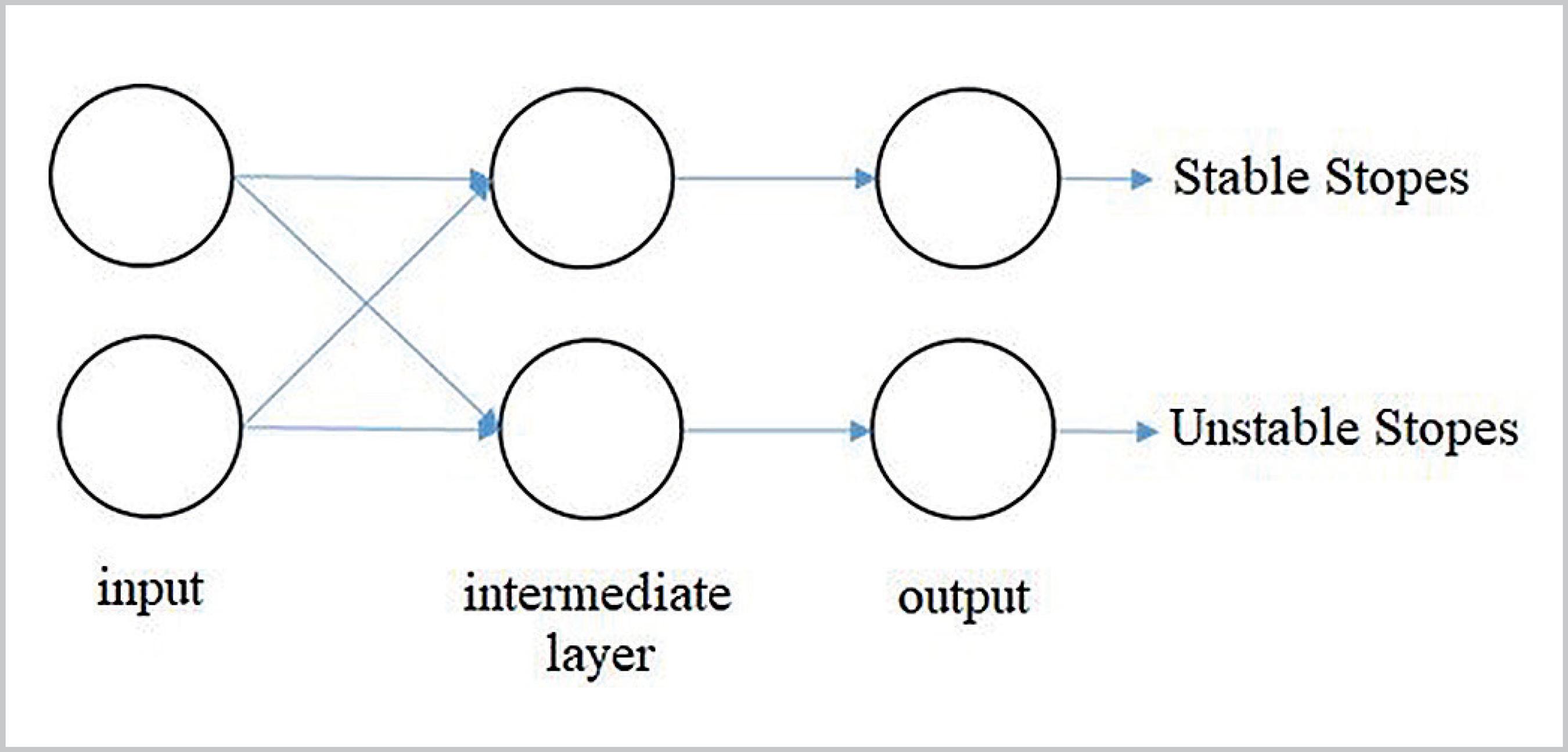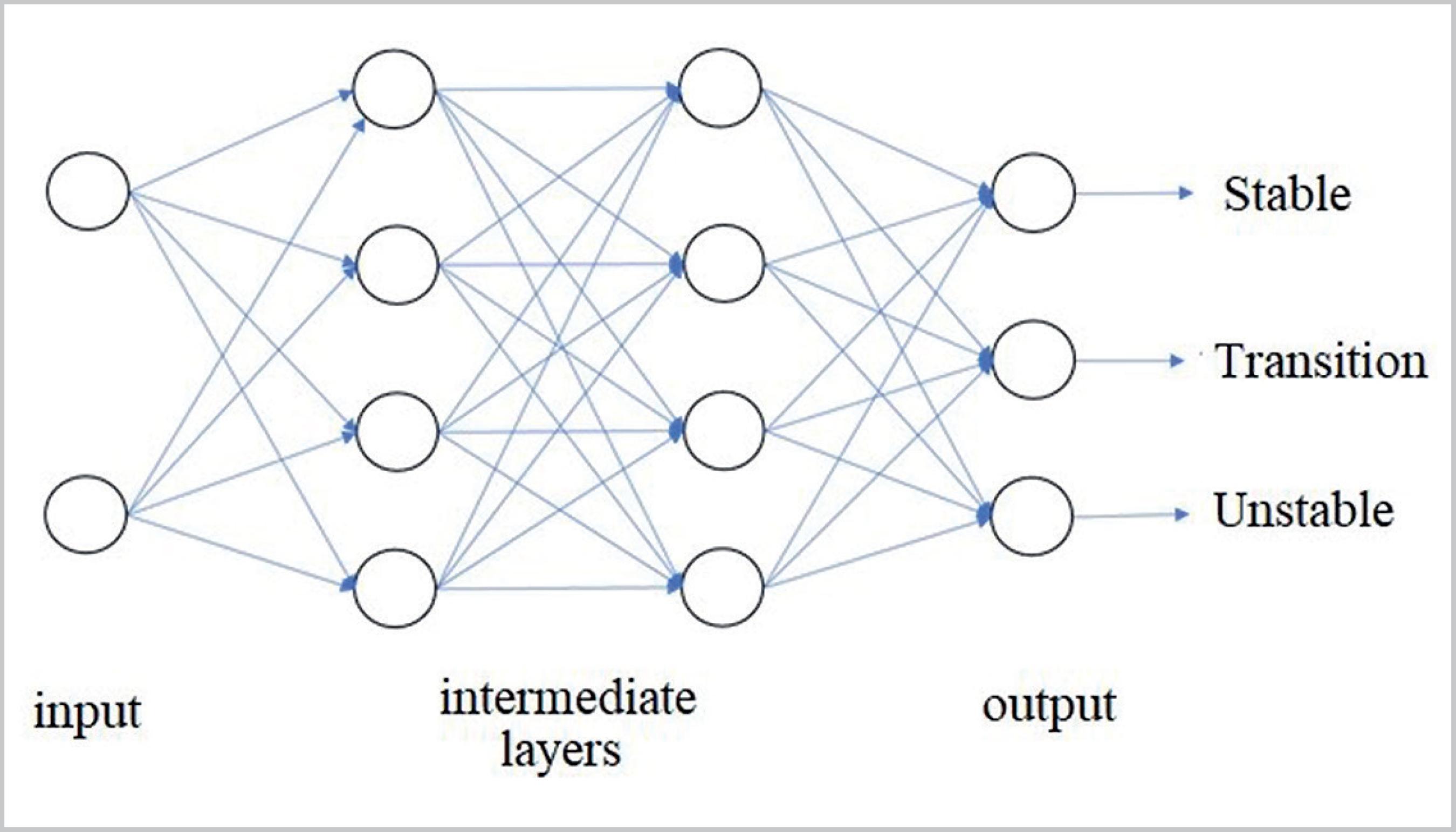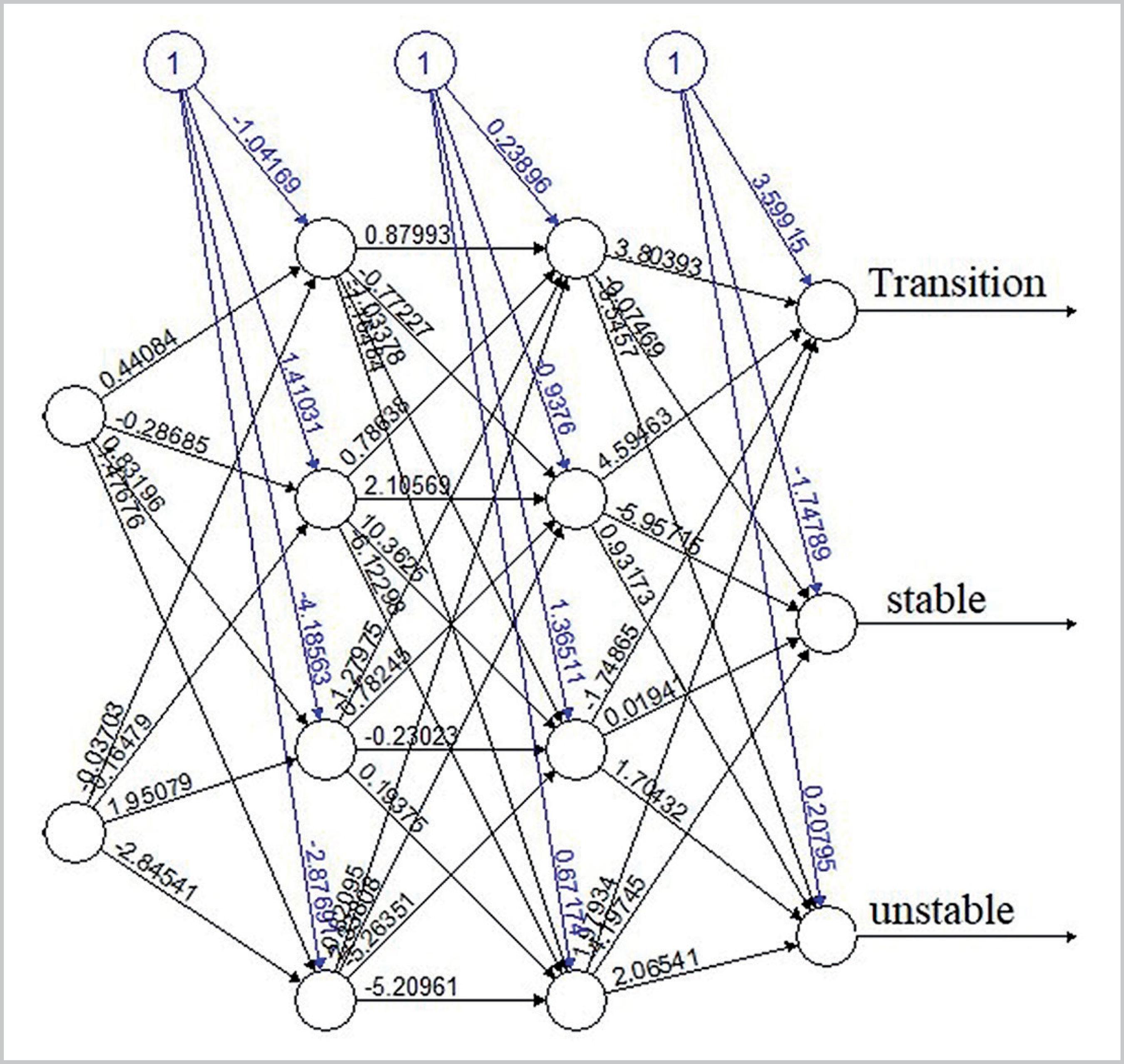Abstract
Underground mining is a set of methods that allows the extraction of ore in depth, ensuring sustainability and economic viability. One of the problems that arise in underground mine operations is open stope stability. The method for assessing stabil ity of open stopes is the stability graph proposed by Mathews et al. (1981). It is possible to estimate and provide information about this stability and assist in the decision mak ing about its viability. With the data obtained from 35 open stopes from a Zinc mine, the present study aims to use artificial intelligence techniques, specifically artificial neural networks, to process the data and classify the open stopes according to the sta bility regions of the graph. As a result, the applied methodology presented good asser tiveness for the classification of two classes, stable and unstable open stopes, resulting in a global probability success of 82% overall hit probability and 18% apparent error rate. For the classification into three classes, adding the transitional open stopes, the internal validation presented a global probability success of 91% and apparent error rate of 9%. In external validation, the network evaluation measures presented values of global probability success of 42% and apparent error rate of 58%.
Keywords:
open stope stability; artificial neural networks; artificial intelligence; sub level stoping
1. Introduction
Outcropping mineral deposits or those situated near surface are increas ingly scarce. Thus, there is a need for research to be carried out in order to better understand the properties of rock masses and the entire Brazilian underground geological context. In addition, it is extremely important to implement new technologies to ensure the productivity of these structures, reducing problems such as dilution and increasing deposit recovery. The stabil ity of the open stopes permits equip ment and people safety, in addition to the operation of the underground mine. The costs of open stop stability in an underground mine are less than those resulting from instability in the rock mass, which provokes equipment dam age, loss of life and dilution of reserves.
In this study, the underground mining method applied is Vertical Retreat Mining, which is a form of the sub-level mining method. In this scenario, the ore grade decreases as the depth of the mine increases. Another relevant aspect that must be observed is the presence of ore lenses around the excavations. Due to the small thickness of these lenses, they end up influencing the stability of the excavation, generat ing areas of weakness where cuttlefish fall. This instability can lead to an increase in the operational dilution, which is a worrying factor in view of the increase in the cost of transporta tion, in the problems caused in the beneficiation stage, and consequently, in the project's revenue.
The methodology currently used is the stability graph proposed by Mathews et al. (1981)MATHEWS, K. E.; HOEK, E.; WYLIE, D. C.; STEWART, S. B. V. Prediction of stable excavation spans for mining at depths below 1,000 m in hard rock mines. Ottawa: CANMET, 1981. (Canmet Report DSS Serial No. OSQ80-00081). for mines 1000 m deep in Canada. However, the results obtained with this methodology have not re sponded well to the field observations of the mine and, in addition, because it is a methodology empirically proposed, the tendency is that it adapts better to the region where it was proposed. Accord ing to Oliveria (2012), it is a constant challenge to estimate this stability in view of anisotropy, heterogeneity, and the presence of discontinuities in rock masses. In relation to the stability graph proposed by Mathews et al. (1981), there are contributions made by Potvin (1988)POTVIN, Y. 1988. Empirical open stope design in Canada. 1988. 350 f. Thesis (PhD) - The University of British Columbia, Vancouver, 1988. , Palkanis (1986) and Mawdesley
et al. (2001).
In view of these problems, the objective of this study is to propose an alternative methodology to assess the stability of an open stope of an underground mine using artificial intel ligence, more specifically, the technique of Artificial Neural Networks (ANNs). This technique capable of receiving an unlimited amount of data and learn its characteristics in order to be able to classify it with the lowest possible error value.
ANN is a computer system struc tured to receive information, interpret it and make decisions based on training (Nola, 2015NOLA I. T. S. Avaliação de dados geológico-geotécnicos prévios para elaboração de carta de eventos perigosos de movimentos de massa gravitacionais por meio de redes neurais artificiais e probabilidade. 2015. 249 f. Dissertação (Mestrado em Geotecnia) - Escola de Engenharia de São Carlos, Universidade de São Paulo, São Carlos, 2015. ). This technique works in a way similar to a neuron, where the sys tem has the ability to "learn" through exposure to a set of input samples combined with the action that would be appropriate for each input (Ferentinou and Fakir, 2017FERENTINOU, M.; FAKIR, M. An ANN approach for the prediction of uniaxial compressive strength, of some sedimentary and igneous rocks in eastern KwaZulu-Natal. Procedia Engineering, v. 191, p.1117-1125, 2017.). The application of these techniques has been widely used in rock mechanics and in particular in the prediction of rock properties, such as in the works of Kahraman et al. (2010)KAHRAMAN, S.; ALBER, M.; FENER, M.; GUNAYDIN, O. The usability of cerchar abrasivity index for the prediction of UCS and E of Misis fault breccia; Regression and artificial neural networks analysis. Expert Systems with Applications, v. 37, n. 12, p. 8750-8756, 2010. ; Rafiai and Jafari (2011)RAFIAI, H.; JAFARI, A. Artificial neural networks as a basis for new generation of rock failure criteria. International Journal of Rock Mechanics and Mining Sciences, v. 48, n. 7, p.1153-1159, 2011. ; Kumas et al. (2011); and Manouchehrian (2012)MANOUCHEHRIAN, A.; SHARIFZADEH, M.; MOGHADAM, R. H. Application of artificial neural networks and multivariate statistics to estimate UCS using textural characteristics. International Journal of Mining Science and Technology, v. 22, n. 2, p. 229-236, 2012. . In addition, other authors were able to predict other geotechnical properties through ANNs, such as in the study by Yang and Rosenbaum (2002)YANG, Y.; ROSENBAUM, M. S. The artificial neural network as a tool for assessing geotechnical properties. Geotechnical & Geological Engineering, v. 20, n. 2, p. 149-168, 2002., who in vestigated the availability of estimating the geotechnical properties of a sand stone based on the geological indicators and the study by Celeste and Oliveira (2019)CELESTE, A. B.; OLIVEIRA, F. H. L. Study of retroanalysis of asphaltic pavements resilience modules with the use of artificial neural networks. Transportes, v. 27, n. 4, p.123-133, 2019. , who estimated the resilience module of asphalt pavements.
2. Materials and methods
The original database consists of two variables: number of stability and hydraulic radius, in addition to the stabil ity status, constituting a total of 35 open stopes. Two situations were studied: the classification in two classes, stable and unstable, and the classification into three classes: stable, unstable and transition.
According to Figure 1, the original database was randomly divided into two samples, the training sample for network training and the test sample for network validation, both corresponding to 50% of the original database. Forty networks were trained for each situation; that is, constituting 40 training and test samples selected at random. The network feed was positive, feedforward, and the learning algorithms used were backpropagation (for two classes) and the resilient back propagation (for three classes).
In this study, two forms of vali dation will be discussed: the internal validation that uses the trained network to predict the classes in the training sample; and external validation that uses the trained network to predict the classes in the test sample. Figure 2 shows the flowchart of validations used in this methodology.
The results of the artificial neural network can be evidenced by confusion matrices shown by Table 1 and Table 2, for the two types of classification studied.
The values n11, n00 and n22 are the number of correct predicted in the clas sification of stable, unstable and transition open stopes, respectively. The values n10 and n12 represent the number of stable open stopes that the network has classified as unstable, or transition. The values n01 and n02 show the number of unstable open stopes classified as stable and in transition. The value n21 and n20 is the number of transition open stopes classified as stable and unstable, respectively.
The evaluation measures of the trained artificial networks were the global prob ability of success (GPS) and the apparent error rate (AER). From Equations 1 and 2, we have the calculation of GPS2 classes and AER2 classes, respectively for classification into two classes. In Equations 3 and 4, GPS3 classes and AER3 classes are calculated, respectively, for classification into three classes.
In the classification into two sta bility classes: stable open stopes and unstable open stopes, the database had a total of 23 highlights. The package used was the neuralnet package, pro posed by Fritsch and Günther (2010)FRITSCH, S.; GÜNTHER, F. Neuralnet: training of neural networks. The R Journal, v. 2, n. 1, p. 30-38, 2010. . The network configuration is in accor dance with Haykin (1999)HAYKIN, S. S. Neural networks: a comprehensive foundation. 2nd ed, Prentice Hall, 1999. 842p. . Two neurons were used in the middle layer, with a hyperbolic tangent activation function. Figure 3 illustrates the structure of the network used.
Structure of the artificial neural network used for classification into two stability classes.
The network errors in this situa tion were calculated and classified as type 1 and type 2, considering only the network errors as a universe. These errors were identified as error 1 where the unstable open stopes are classified as stable (Equation 5); and error 2 where stable open stopes are classified as un stable (Equation 6).
In the case of three stability classes: stable open stope, transition open stope and unstable open stope, the database had a total of 35 open stopes. The package used was the neuralnet package, proposed by Fritsch and Günther (2010)FRITSCH, S.; GÜNTHER, F. Neuralnet: training of neural networks. The R Journal, v. 2, n. 1, p. 30-38, 2010. . In this problem, two intermediate layers were used with four neurons in each layer, with a hyperbolic tangent activation function. The network learning algorithm was the resilient backpropagation. Figure 4 illus trates the structure of the network used.
3. Results and discussions
Figure 5 shows the scatterplot graphs for the hydraulic radius of variables and stability number for the open stopes in the two classification situations under study, being the condi tion for two classes and the condition for three classes. It is observed that the distribution of the open stopes in transition makes it difficult to sepa rate into areas, such as in the stability graphs of Mathews et al. (1981)MATHEWS, K. E.; HOEK, E.; WYLIE, D. C.; STEWART, S. B. V. Prediction of stable excavation spans for mining at depths below 1,000 m in hard rock mines. Ottawa: CANMET, 1981. (Canmet Report DSS Serial No. OSQ80-00081). and Potvin (1988)POTVIN, Y. 1988. Empirical open stope design in Canada. 1988. 350 f. Thesis (PhD) - The University of British Columbia, Vancouver, 1988. .
First, for the classification problem in two classes: stable open stope and unstable open stope, Figures 6 and 7 show the be havior of the GPS2 classes and AER2 classes of the network trained in internal and external validation for the 40 iterations performed, respectively. In Figures 6 and 7, notice that in the internal validation, the network presents a stable result, without representative peaks.
In external validation, it is pos sible to observe three peaks of increase in AER2 classes , but if compared to the number of iterations performed, these isolated peaks do not compromise the stability of the net work. In addition, it is possible to observe points where the network correctly classifies all highlights. Table 3 shows the statistical summary of the results of the network.
In validations, the network pre sented an average GPS2 classes of 88% and 83%, with a minimum value of 75%. This is a remarkable result since the network presents high values of global probability of correctness in the great majority of the iterations it performs. In relation to AER2 classes, when stratifying the two types of errors that the network can make, Error 1 appears with greater recur rence, representing on average 61% of the total errors of each generated network, as shown in Table 3. Error 2 represents on average 29% of the total errors of each generated network. This can interpret as a non-conservative trend in the network, since Error 1, whose unstable open stopes were classified as stable, occurred more frequently. Figure 8 shows what one of the networks obtained for this classifica tion condition.
Regarding the results for the clas sification problem into three classes: stable, unstable and transition enhance ments, Figures 9 and 10 show the re sults obtained regarding GPS3 classes and AER3 classes, in the internal and external validations, respectively. Table 4 shows the statistical summary for the neural network assessment measures.
In the internal validation the GPS3 classes was, on average, equal to 91%, with maximum values of 100% in some iterations, and the AER3 classes equal to 9% on average, and these are very relevant results due to the complex ity of the problem. Regarding external validation, the results oscillated in average values of 42% and 58%, for GPS3 classes and AER3 classes, which are considered low values. The low number of enhancement data and the complex ity of the classification in three overly ing classes culminated in these results. Figure 11 shows one of the networks obtained for the condition of classifica tion into three classes: stable, unstable and transition highlights.
4. Conclusions
The proposed methodology proved to be capable of being used to assess the open stope stability. The networks were able to identify pat terns and satisfactorily classify the studied open stopes. Two situations were presented: two stability classes and three stability classes. The results for the first situation proved to be more effective.
In the first situation addressed, for internal validation, on average the GPS2 classes was 88% and AER2 classes was 12% and for external validation, on average the rates were 83% and 17%. In the classification for three classes, the most complex situation studied in herein, the results for internal valida tion were 91% for GPS3 classes and 9% for AER3 classes. However, for external validation the results were not satisfac tory, with the GPS3 classes found equal to 42% and the AER3 classes equal to 58% and this may be due to the small number of data available for the study.
This research is innovative and the results obtained can be an alter native methodology to the Stability Graph, mainly considering the results of the situation for two classes.
Acknowledgements
The authors would like to thank Brazilian Research Council (CNPq) for supporting this research.
References
- CELESTE, A. B.; OLIVEIRA, F. H. L. Study of retroanalysis of asphaltic pavements resilience modules with the use of artificial neural networks. Transportes, v. 27, n. 4, p.123-133, 2019.
- FERENTINOU, M.; FAKIR, M. An ANN approach for the prediction of uniaxial compressive strength, of some sedimentary and igneous rocks in eastern KwaZulu-Natal. Procedia Engineering, v. 191, p.1117-1125, 2017.
- FRITSCH, S.; GÜNTHER, F. Neuralnet: training of neural networks. The R Journal, v. 2, n. 1, p. 30-38, 2010.
- HAYKIN, S. S. Neural networks: a comprehensive foundation. 2nd ed, Prentice Hall, 1999. 842p.
- KAHRAMAN, S.; ALBER, M.; FENER, M.; GUNAYDIN, O. The usability of cerchar abrasivity index for the prediction of UCS and E of Misis fault breccia; Regression and artificial neural networks analysis. Expert Systems with Applications, v. 37, n. 12, p. 8750-8756, 2010.
- KUMAR, B. R.; VARDHAN, H.; GOVINDARAJ, M. Prediction of uniaxial compressive strength, tensile strength and porosity of sedimentary rocks using sound level produced during rotary drilling. Rock Mechanics and Rock Engineering, v. 44, p. 613-620, 2011.
- MANOUCHEHRIAN, A.; SHARIFZADEH, M.; MOGHADAM, R. H. Application of artificial neural networks and multivariate statistics to estimate UCS using textural characteristics. International Journal of Mining Science and Technology, v. 22, n. 2, p. 229-236, 2012.
- MATHEWS, K. E.; HOEK, E.; WYLIE, D. C.; STEWART, S. B. V. Prediction of stable excavation spans for mining at depths below 1,000 m in hard rock mines Ottawa: CANMET, 1981. (Canmet Report DSS Serial No. OSQ80-00081).
- NOLA I. T. S. Avaliação de dados geológico-geotécnicos prévios para elaboração de carta de eventos perigosos de movimentos de massa gravitacionais por meio de redes neurais artificiais e probabilidade 2015. 249 f. Dissertação (Mestrado em Geotecnia) - Escola de Engenharia de São Carlos, Universidade de São Paulo, São Carlos, 2015.
- OLIVEIRA, M. M.; PINTO, C. L. L.; DUTRA, J. l. G. Potvin stability graph applied to brazilian geomechanic envi ronment. REM - Revista Escola de Minas, v. 67, n. 4, p. 413-419, 2014.
- POTVIN, Y. 1988. Empirical open stope design in Canada 1988. 350 f. Thesis (PhD) - The University of British Columbia, Vancouver, 1988.
- RAFIAI, H.; JAFARI, A. Artificial neural networks as a basis for new generation of rock failure criteria. International Journal of Rock Mechanics and Mining Sciences, v. 48, n. 7, p.1153-1159, 2011.
- YANG, Y.; ROSENBAUM, M. S. The artificial neural network as a tool for assessing geotechnical properties. Geotechnical & Geological Engineering, v. 20, n. 2, p. 149-168, 2002.
Publication Dates
-
Publication in this collection
22 June 2020 -
Date of issue
Jul-Sep 2020
History
-
Received
05 Feb 2020 -
Accepted
29 Mar 2020












